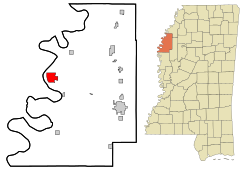Rosedale, Mississippi
| Rosedale, Mississippi | |
|---|---|
| City | |
| Motto: The Delta City of Brotherly Love | |
 Location of Rosedale, Mississippi |
|
| Location in the United States | |
| Coordinates: 33°51′13″N 91°1′37″W / 33.85361°N 91.02694°WCoordinates: 33°51′13″N 91°1′37″W / 33.85361°N 91.02694°W | |
| Country | United States |
| State | Mississippi |
| County | Bolivar |
| Area | |
| • Total | 5.5 sq mi (14.2 km2) |
| • Land | 5.4 sq mi (14.0 km2) |
| • Water | 0.08 sq mi (0.2 km2) |
| Elevation | 151 ft (46 m) |
| Population (2010) | |
| • Total | 1,873 |
| • Density | 346/sq mi (133.6/km2) |
| Time zone | Central (CST) (UTC-6) |
| • Summer (DST) | CDT (UTC-5) |
| ZIP code | 38769 |
| Area code(s) | 662 |
| FIPS code | 28-63720 |
| GNIS feature ID | 0676870 |
| Website | www |
Rosedale is a city in Bolivar County, Mississippi, United States. The population was 1,873 at the 2010 census, down from 2,414 in 2000. Located in an agricultural area, the city had a stop on the Yazoo and Mississippi Valley Railroad, which carried many migrants north out of the area in the first half of the 20th century.
Bluesman Robert Johnson referred to this city in his song "Travelling Riverside Blues" as did Lucinda Williams in her song "2 Kool to be 4 Gotten"
This area in the nineteenth century was developed by European American planters for extensive cotton plantations, dependent on enslaved laborers. After the Civil War and emancipation, some freedmen managed to clear and buy land in the bottomlands, with many becoming landowners before the end of the nineteenth century. By 1910, a lengthy recession and declining economic and political conditions resulted in most blacks in the state losing their land. They could not compete with the financing gained by railroads, which were constructed in the area beginning in 1882 Many stayed in the area to work as sharecroppers and laborers. The railroad brought new business to Rosedale, which had a depot and shipped cotton to northern and other markets.
Beginning in the early twentieth century, tens of thousands of blacks left the state of Mississippi as part of the Great Migration, north by railroad to Chicago and other Midwestern industrial cities. During and after World War II, others went to California to work in the defense industry. Others remained where their families had lived for generations, with strong local ties.
...
Wikipedia

